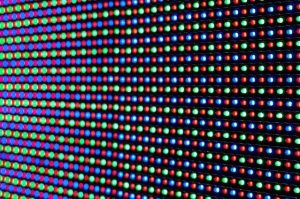 With any electronically created image there is a grid, or an array made of dots or squares that are called pixels. This is true for a live dot flip board, a direct view LED display, OLED, LCD, DLP, D-ILA, Micro LED quantum dots, or any other technology. This pixel structure is the base component of the image. An image (size?) is simply a sum of many pixels that each light up to a specific brightness or color to create a completed image. Pixels have a few major things they all share regardless of technology.
With any electronically created image there is a grid, or an array made of dots or squares that are called pixels. This is true for a live dot flip board, a direct view LED display, OLED, LCD, DLP, D-ILA, Micro LED quantum dots, or any other technology. This pixel structure is the base component of the image. An image (size?) is simply a sum of many pixels that each light up to a specific brightness or color to create a completed image. Pixels have a few major things they all share regardless of technology.
Today I am talking about relative position i.e. how close each pixel is from a centerline to the next pixel’s centerline. This pixel to pixel distance or space is the display pixel density and is calculated using a variable that has labeled P because it also equals the total pixel size. The closer the pixels are the more density there is in a display. The closer the pixels are the more pixels there are per square meter or foot. But P isn’t relative and can be found in two ways.
First, you can find P by array total. For total pixel count, you solve for the new pixel count first in the X, Y direction, then simply multiply the answer out. So, if 4 by 4 image is 4×4=16 pixels and you double the density to get 8 by 8 which is 8×8=64 pixels.
The second way to find P is by the combined difference multiplier in each direction. For doubling a display’s density, the distance X increased by a factor of 2. So, 2 x 2 = 4, and using the prior total of 16, multiply that by the difference factor which is 4. 16 x 4 = 64. Same answer.
Shown both ways if you triple the density, 12 x 12 pixels you have 144 pixels or 3×3 = 9. 16 x 9 = 144. But why do a difference rather than an array you may ask? Well, the answer is that if you have a display that is not a complete array when you calculate the pixels you have to subtract out the non-full array section. In a difference, if there were 100 pixels before and you double the pixel density you have 400 pixels regardless of where they are. So, it can be easier at times to use a total pixel count difference rather than using an X, Y-axis count. It depends on what you are solving for.

